Alliums are popular plants known for their striking and colorful flowers blooming in late spring and summer. But as with any plant, it can also develop problems, and one of the most common is allium leaves turning yellow.
While some yellowing is natural and nothing to worry about, it can also be a sign of a more serious issue that requires attention.
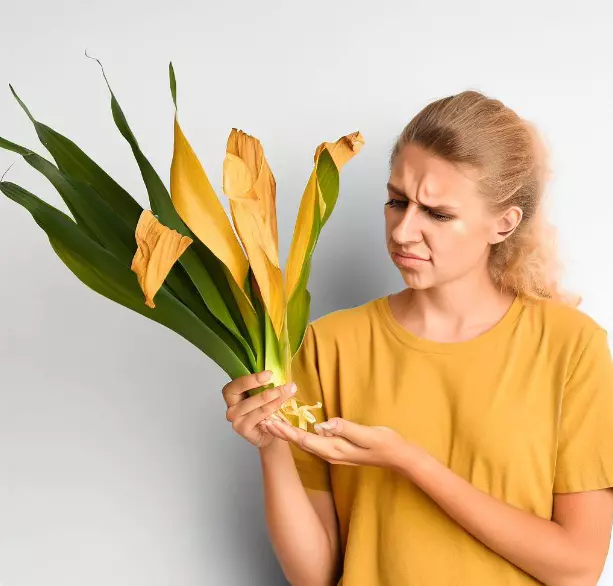
In this article, we’ll discuss reasons for allium leaves turning yellow and offer practical advice on diagnosing and treating the problem.
We’ll also provide tips on preventing yellowing leaves from occurring in the first place. Whether you’re a seasoned gardener or a beginner, this guide will help keep your allium plants healthy and thriving.
Table of Contents
Allium Leaves Turning Yellow (All the Major Causes)
Alliums are typically hardy plants that can tolerate various growing conditions. However, they are still susceptible to various issues, including yellowing leaves.
Yellowing leaves can be caused by several factors, from environmental stressors like water and temperature fluctuations to nutrient deficiencies and even disease and pest infestations.
This section will explore these causes in more detail and provide practical advice on addressing them. Understanding the reasons behind yellowing leaves is essential for maintaining the health and vibrancy of your allium plants, so let’s dive in.
Environmental factors
Allium plants are sensitive to changes in their environment, and various factors can cause their leaves to turn yellow. These factors can include issues with watering, sunlight exposure, temperature fluctuations, and soil pH levels.
Let’s look closely at these environmental factors, including their effects on allium plants and how to manage them effectively.
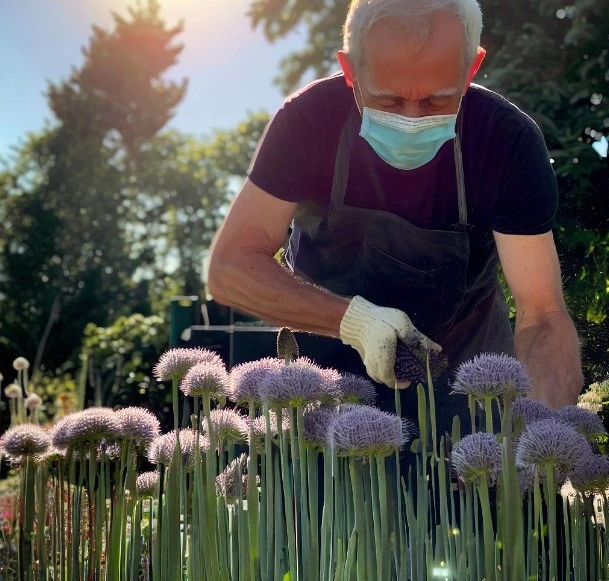
Lack of water
A lack of water is one of the most common causes of yellowing leaves in allium plants. When allium plants don’t receive enough water, they can become water-stressed, which can cause their leaves to turn yellow and wilt.
Signs of water stress can include curling or drooping leaves, a lack of new growth, and yellowing leaves.
To prevent this water stress, it’s essential to ensure that your allium plants receive enough water, especially during hot and dry periods.
A good rule of thumb is to water allium plants once a week or whenever the top inch of soil feels dry to the touch. Mulching around the plant’s base can also help retain moisture in the soil and prevent water stress.
Excess water
While a lack of water can cause yellowing leaves, so can excess water. Overwatering allium plants can lead to waterlogged roots, preventing the plants from taking up essential nutrients and oxygen.
Symptoms of overwatering can include yellowing leaves that appear wilted or slimy, as well as a foul odor from the soil.
To prevent overwatering, try to ensure allium plants are planted in well-draining soil that allows excess water to drain away. You can also reduce the risk of overwatering by waiting until the top inch of soil feels dry to the touch before watering again.
You can also improve drainage by adding organic matter to the ground or planting alliums in raised beds.
Temperature fluctuations
Allium plants are sensitive to extreme temperatures, and sudden fluctuations in temperature can cause their leaves to turn yellow. Extreme heat or cold can stress the plants, causing them to wilt and lose color.
In severe cases, these types of plants may even die as a result of temperature stress. To protect them from temperature fluctuations, consider planting them in a location that provides some protection from extreme heat or cold.
For example, planting them near a wall or fence can help shield them from the sun’s rays or harsh winter winds. You can also provide extra insulation by adding mulch around the base of the plants or covering them with a frost cloth during periods of extreme cold.
Soil pH levels
Soil pH levels are another factor that can significantly impact the health of allium plants. Alliums prefer soil with a pH level of somewhere between 6.0 and 7.0. Furthermore, too acidic or alkaline soils can cause nutrient deficiencies that can lead to yellowing leaves.
It’s essential to test the soil pH regularly to ensure it falls within this range and make adjustments if necessary. To raise the pH of acidic soil, you can add lime, while to lower the pH of alkaline soil, you can add elemental sulfur or aluminum sulfate.
It’s essential to make any adjustments slowly and to test the soil pH again after a few weeks to ensure it has reached the desired level.
Sunlight
Sunlight exposure is another potential issue that can cause Allium leaves to turn yellow. Too much sunlight can lead to sunscald, which can cause yellowing and brown spots on the leaves.
Whereas too little sunlight can prevent the plants from producing enough chlorophyll, leading to yellowing. To manage sunlight exposure for allium plants, try choosing a location that provides the right amount of sunlight for the plant’s needs.
Alliums prefer full sun, but they can also tolerate some shade. If your plants are receiving too much sunlight, you can provide shade via either shade cloth or by planting them near taller plants or structures that will block the sun’s rays.
Conversely, if your plants are not receiving enough sunlight, you can prune back any nearby plants or structures that may be blocking the sun’s rays.
Nutrient deficiencies
Nutrient deficiencies can also be a cause of yellowing leaves in allium plants. Alliums require certain nutrients to thrive, and if these nutrients are lacking, yellow leaves and other signs of poor plant health will appear.
This section will explore some of the most common nutrient deficiencies in alliums and offer tips on preventing and treating them.
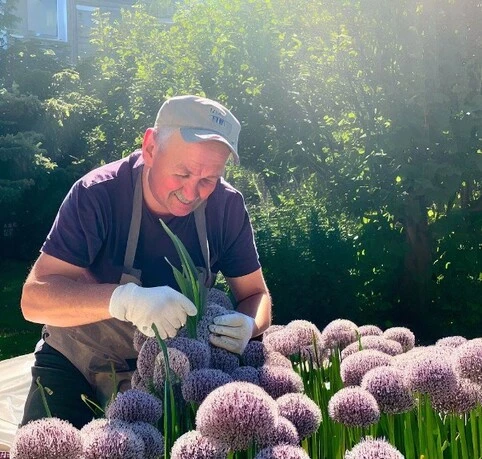
Nitrogen deficiency
Nitrogen is an essential nutrient for allium plants. Therefore a lack of nitrogen can cause the leaves to turn yellow. Symptoms of nitrogen deficiency can include:
- Pale yellow or greenish-yellow leaves
- Stunted growth
- Poor flowering.
To prevent nitrogen deficiency, it’s essential to provide allium plants with a balanced fertilizer that contains nitrogen. You can also add organic matter, such as compost or well-rotted manure, to the soil to increase nitrogen levels.
If your allium plants are already showing signs of nitrogen deficiency, you can apply a nitrogen-rich fertilizer to the soil, such as blood meal or fish emulsion.
It’s essential to follow the manufacturer’s instructions carefully and not to over-fertilize, as this can lead to other nutrient imbalances.
Phosphorus deficiency
Phosphorus is another essential nutrient for allium plants, and a lack of phosphorus can cause the leaves to turn yellow. Symptoms of phosphorus deficiency can include:
- Yellowing leaves that are smaller than usual
- Weak stems
- Poor flowering.
To prevent phosphorus deficiency, providing Allium plants with a balanced fertilizer that contains phosphorus. You can also add bone meal or rock phosphate to the soil to increase phosphorus levels. If your allium plants already show signs of phosphorus deficiency, you can apply a phosphorus-rich fertilizer to the soil.
Potassium deficiency
Potassium is also an essential nutrient for allium plants, and a lack of potassium can cause the leaves to turn yellow. Symptoms of potassium deficiency can include:
- Yellowing leaves
- Brown spots
- Weak stems.
To prevent potassium deficiency, providing allium plants with a balanced fertilizer that contains potassium is vital. You can also add potash to the soil to increase potassium levels. If your allium plants already show signs of potassium deficiency, you can apply a potassium-rich fertilizer to the soil.
Diseases and pests
Diseases and pests are other leading culprits for yellowing leaves in allium plants. The damage they cause can weaken the plant and cause the leaves to turn yellow.
This section will go through the most common pests and diseases that affect alliums and offer tips on preventing and treating them.
Onion fly
Onion fly is a common pest that affects allium plants, particularly onions and garlic. Here’s what you need to know about identifying and controlling onion flies:
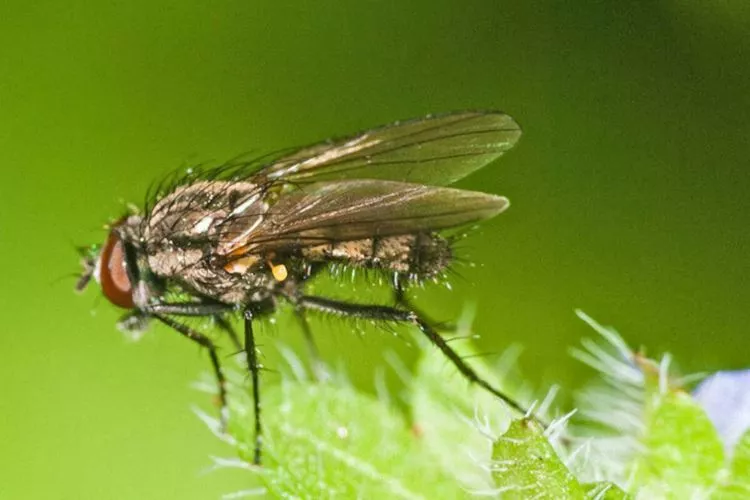
- What do they look like?
- Onion flies are small, dark-colored flies with yellowish heads and shiny bodies. They are about 1/4 inch in length and are often seen flying near allium plants.
What are the symptoms?
The symptoms of onion fly infestation include:
- Yellowing and wilting of the leaves.
- Stunted growth.
- Tiny, white grubs in the bulbs.
You may also notice small, brown patches on the leaves or bulbs.
- What damage do they cause?
- Onion fly maggots can cause significant damage to allium plants, feeding on the roots and bulbs and causing them to rot. Infected plants may also become more susceptible to fungal and bacterial diseases.
- How can you treat them?
- Remove and dispose of any infected plant material and bulbs to control onion fly infestations. You can also try using sticky traps or insecticides containing spinosad, a natural compound derived from soil bacteria. Be sure to follow the manufacturer’s instructions carefully when using insecticides.
- How can you prevent them?
- To prevent onion fly infestations, practice good sanitation and avoid overcrowding and overwatering. Consider planting alliums in well-draining soil and using row covers to protect them from flies. You can also try companion planting with plants that repel onion flies, such as herbs like thyme and basil.
Onion maggot
Onion maggot is another common pest that affects allium plants, particularly onions. Here’s what you need to know about spotting and managing onion maggots:
- What do they look like?
- Onion maggots are small, white, or yellowish larvae that resemble tiny worms. They are about 1/3 inch long and can be found in the soil near the base of allium plants.
- What are the symptoms?
- The symptoms of onion maggot infestation include yellowing and wilting of the leaves, stunted growth, and larvae in the bulbs. You may also notice small, brown patches on the leaves or bulbs.
- What damage do they cause?
- Onion maggots feed on the roots and bulbs of allium plants, causing them to become soft and mushy. Infected plants may also become more susceptible to fungal and bacterial diseases.
- How can you treat them?
- Remove and dispose of any infected plant material and bulbs to control onion maggot infestations. You can also try using insecticides containing spinosad, a natural compound derived from soil bacteria. Be sure to follow the manufacturer’s instructions carefully when using insecticides.
- How can you prevent them?
- To prevent onion maggot infestations, avoid planting alliums in the same location for more than two years. Consider using row covers or other physical barriers to protect plants from flies. You can also try planting alliums in well-draining soil and using companion planting with plants that repel onion maggots, such as chamomile or marigolds.
Fungal diseases
Fungal diseases can present in different ways depending on the type of fungus, but generally, you may notice spots or patches on the leaves, stems, or bulbs. These spots can be yellow, brown, black, or white and may have a fuzzy or powdery appearance.
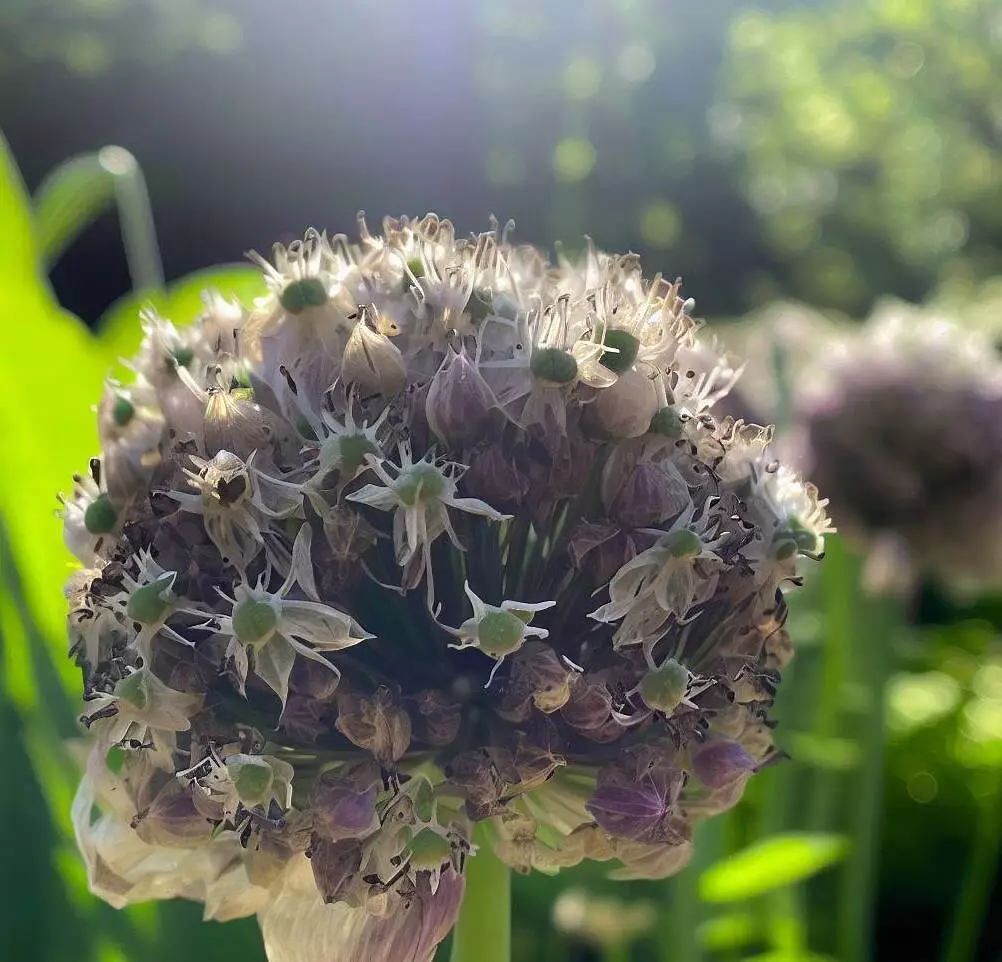
- What are the symptoms?
- Symptoms of fungal diseases in allium plants include yellowing or browning of the leaves, wilting, and premature death of the plant. You may also notice soft or mushy spots on the bulbs.
- What damage do they cause?
- Fungal diseases can cause significant damage to allium plants, including reduced growth and yield and increased susceptibility to other pests and diseases.
- How can you treat them?
- Remove and dispose of any infected plant material, including leaves and bulbs, to control fungal diseases. You can also apply fungicides containing copper, sulfur, or other natural compounds to prevent the spread of the fungus. Be sure to follow the manufacturer’s instructions carefully when using fungicides.
- How can you prevent them?
- Avoid planting alliums in wet or poorly drained soil to prevent fungal diseases. You can also promote good air circulation by spacing plants properly and avoiding overcrowding. Finally, be sure to water allium plants at the base of the plant, rather than from overhead, to reduce humidity and prevent water from sitting on the leaves.
Bacterial diseases
Fungal diseases are a common problem for allium plants, especially in wet or humid conditions. Here’s what you need to know about identifying and controlling fungal diseases:
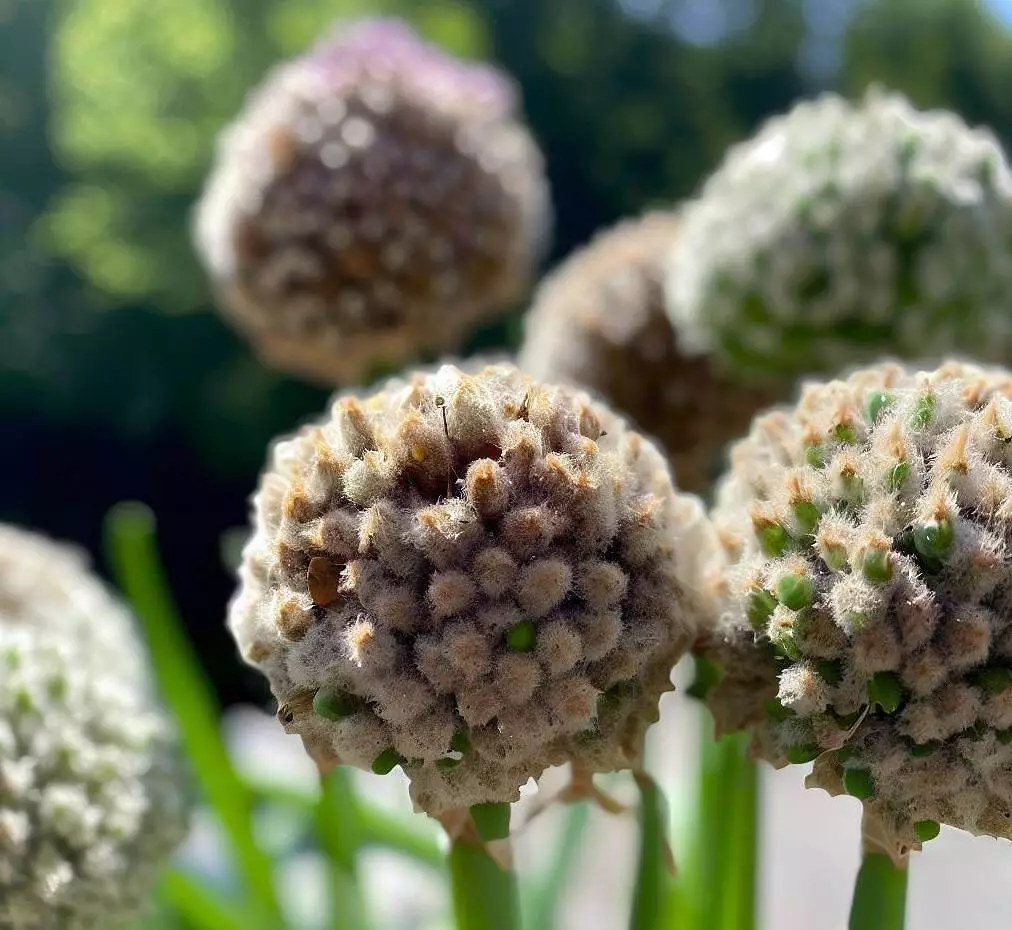
- What do they look like?
- Fungal diseases can present in different ways depending on the type of fungus, but generally, you may notice spots or patches on the leaves, stems, or bulbs. These spots can be yellow, brown, black, or white and may have a fuzzy or powdery appearance.
- What are the symptoms?
- Symptoms of fungal diseases in allium plants include yellowing or browning of the leaves, wilting, and premature death of the plant. You may also notice soft or mushy spots on the bulbs.
- What damage do they cause?
- Fungal diseases can cause significant damage to allium plants, including reduced growth and yield and increased susceptibility to other pests and diseases.
- How can you treat them?
- Remove and dispose of any infected plant material, including leaves and bulbs, to control fungal diseases. You can also apply fungicides containing copper, sulfur, or other natural compounds to prevent the spread of the fungus. Always follow the manufacturer’s instructions carefully when using fungicides.
- How can you prevent them?
- Avoid planting alliums in wet or poorly drained soil to prevent fungal diseases. You can also promote good air circulation by spacing plants properly and avoiding overcrowding. Finally, make sure you water these plants at their base rather than from above; this will help to reduce humidity and prevent water from sitting stagnant on the leaves.
Diagnosis of Yellowing Leaves on Allium Plants
Once you have identified that your allium plants are showing signs of yellowing leaves, it is important to diagnose the underlying cause of the issue.
A proper diagnosis can help determine the best course of action to treat the problem and prevent further damage to the plant. In this section, we’ll review some simple methods for diagnosing yellowing leaves on allium plants.
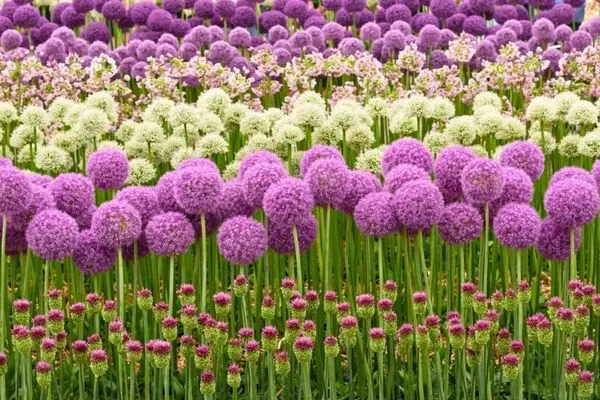
Observation of the plant
The first step in diagnosing yellowing leaves on allium plants is to observe the plant and look for visual symptoms. Take note of the pattern of yellowing, whether it starts at the tips of the leaves or the base, as well as any other changes in the leaves, such as spotting, wilting, or curling.
Soil testing
Another critical step in diagnosing yellowing leaves on allium plants is to conduct a soil test. Soil testing can help determine if there are any nutrient imbalances or pH problems that may be contributing to the issue. Testing should be done before planting and periodically throughout the growing season.
To conduct a soil test, collect a soil sample from several locations in your garden bed or container, mix them, and send the sample to a reputable testing laboratory for analysis.
Laboratory analysis
In some cases, it may be necessary to seek professional help and send a sample of the affected plant to a laboratory for analysis. This is especially true if you have ruled out environmental factors and nutrient deficiencies as the cause of the yellowing leaves.
A laboratory analysis can help identify any diseases or pests affecting the plant. The analysis will also provide specific recommendations for treatment and prevention based on the results.
Treatment of Yellowing Leaves on Allium Plants
To treat yellowing leaves on allium plants, it is important to address the underlying cause of the problem. This section will provide practical advice on environmental and nutrient management and pest and disease control to help restore the health of your allium plants.
Environmental management
Environmental management is a crucial aspect of treating yellowing leaves on allium plants. Proper water, soil pH, and sunlight management can significantly improve plant health and prevent the yellowing of leaves.
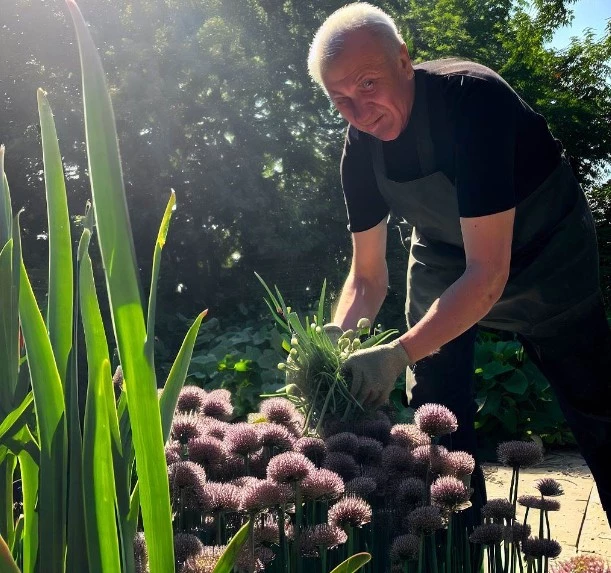
Water management
Proper watering is crucial to prevent yellowing leaves on allium plants. The symptoms of water stress, including wilting, dry soil, and yellowing leaves, can be alleviated by watering the plant deeply and regularly.
Overwatering can also cause yellowing leaves and other problems like root rot, so it’s important to ensure proper drainage and avoid excessive watering.
Soil pH management
Allium plants prefer slightly acidic soil with a pH range between 5.5 and 7.0. To adjust the soil pH, add sulfur or aluminum sulfate to decrease pH or lime to increase it.
Soil pH imbalances can lead to nutrient deficiencies and other issues, so it’s important to regularly test and amend the soil as needed. Testing can help to prevent any future problems.
Sunlight management
Allium plants require full sun to partial shade, depending on the variety. Too much sunlight can cause leaf scorch and wilting, while too little can result in poor growth and yellowing leaves.
It’s important to provide the plant with the appropriate amount of sunlight based on its specific needs and to provide shade during the hottest parts of the day if necessary.
Nutrient management
Allium plants require a balanced nutrient supply to grow and thrive. Proper nutrient management can help prevent deficiencies that can lead to yellowing leaves. Here are some tips for managing nutrients in allium plants:
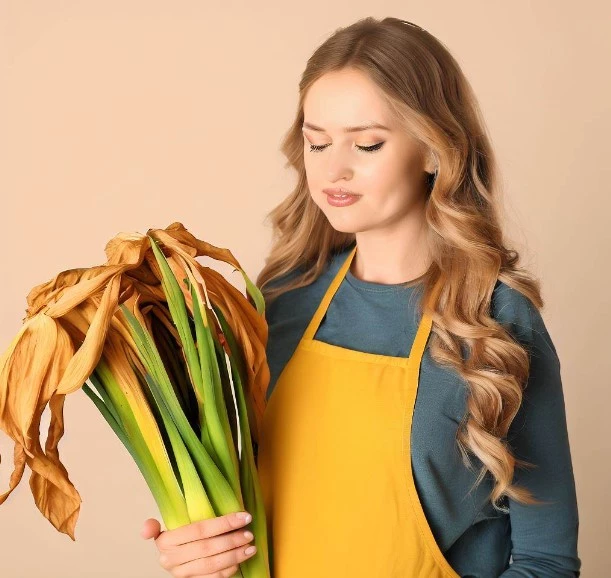
Nitrogen management
Nitrogen is an essential nutrient for allium plants, and deficiency can cause the yellowing of leaves. Adequate nitrogen can be provided through nitrogen-rich fertilizers or organic matter. Here are some tips for managing nitrogen:
- Apply a balanced fertilizer with nitrogen as the primary nutrient, following the recommended application rate.
- Use organic matter such as compost, manure, or blood meal, which can release nitrogen slowly over time.
- Avoid excessive nitrogen application, which can lead to overgrowth and reduced bulb formation.
Phosphorus management
Phosphorus is another essential nutrient for allium plants, and deficiency in this nutrient can also cause the yellowing of leaves. Apply enough phosphorus to satisfy all its needs using phosphorus-rich fertilizers or organic matter. Here are some tips for managing phosphorus:
- Apply a balanced fertilizer with phosphorus as the primary nutrient, following the recommended application rate.`
- Use organic matter such as bone meal or rock phosphate, which can release phosphorus slowly over time.
- Avoid excessive phosphorus application, as it can lead to nutrient imbalances and reduced plant growth.
Potassium management
Potassium is also one of the essential food forms for allium plants, and its deficiency will also cause the yellowing of leaves, stunted growth, and reduced bulb formation. Try to use potassium-rich fertilizers or organic matter to boost them when required. Here are some tips for managing potassium:
- Apply a balanced fertilizer with potassium as the primary nutrient, following the recommended application rate.
- Use organic matter such as wood ashes or kelp meal, which can release potassium slowly over time.
- Avoid excessive potassium application, as it can lead to salt buildup in the soil and reduced plant growth.
Disease and pest management
Pests and diseases can also cause the yellowing of leaves in allium plants. Here are some tips for managing pests and diseases:
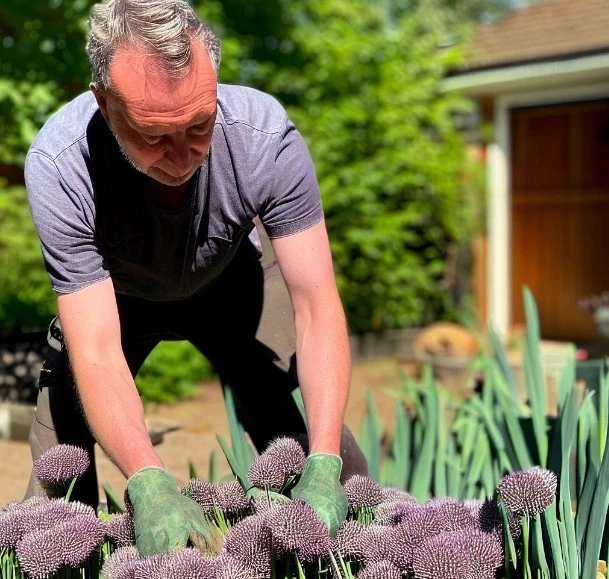
Onion fly and onion maggot management
Onion fly and onion maggot can cause severe damage to allium plants. Preventing infestations is crucial to preventing the yellowing of leaves. Here are some tips for managing onion flies and onion maggots:
- Protective covers, such as insect netting, prevent flies from laying eggs on the soil.
- Follow the manufacturer’s instructions to apply insecticides or repellents containing natural substances like neem oil or pyrethrin.
- Practice crop rotation to prevent a buildup of onion fly and maggot populations in the soil.
Bacterial disease management
Finally, Bacterial diseases also going to cause headaches in the form of yellowing of leaves and other symptoms in allium plants. Preventing and treating bacterial diseases is best done fast and swiftly. Here are some tips for managing bacterial diseases:
- Use fundamental cultural practices such as adequate spacing, good air circulation, and proper watering techniques to prevent the spread of bacterial diseases.
- Apply antibiotics or copper-based bactericides, following the manufacturer’s instructions.
- Remove infected plant material as soon as you spot any and get rid of it so that it cannot spread and cause further damage.
Prevention of Yellowing Leaves on Allium Plants
Prevention is always better than cure, which also holds true for allium plants. Adopting good cultural practices and proper soil management techniques can prevent yellowing leaves on your allium plants. This section will provide practical advice on soil preparation, planting methods, crop rotation, and cultural practices that can help keep your allium plants healthy and vibrant.
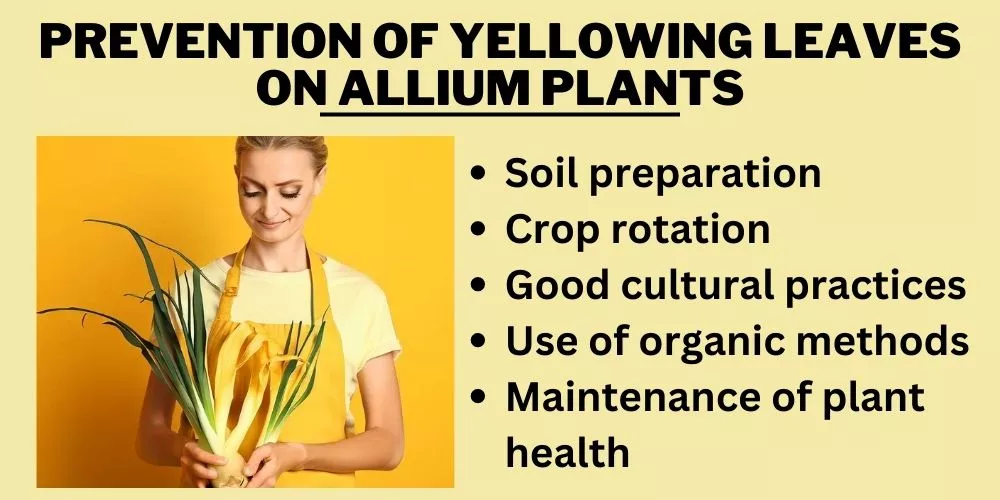
Following these tips can minimize the risk of yellowing leaves and ensure that your allium plants thrive throughout the growing season.
Soil preparation
Soil preparation involves ensuring that the soil is rich in nutrients and has the proper pH level for allium plants to thrive. This can be achieved by adding organic matter, such as compost or manure, and regularly testing the soil to ensure it is at the optimal pH level for allium plants.
Crop rotation
Crop rotation is a practice that involves planting different crops in different locations each year to prevent the buildup of pests and diseases in the soil. By rotating allium plants with other crops, gardeners can prevent the accumulation of harmful microorganisms in the soil and keep the plants healthy.
Good cultural practices
Good cultural practices involve maintaining good hygiene in the garden, such as removing plant debris and weeds and providing adequate air circulation around the plants. This can prevent the spread of diseases and pests that can cause the yellowing of the leaves.
Use of organic methods
Using organic pest and disease control methods, such as companion planting and beneficial insects, can also prevent yellowing leaves in allium plants. Companion planting involves planting plants with natural pest-repelling properties near allium plants to deter harmful insects. Beneficial insects, such as ladybugs and lacewings, can also be introduced to the garden to control pests.
Maintenance of plant health
Maintaining the overall health of allium plants is essential in preventing yellowing leaves. This includes proper watering, fertilizing, and pruning. By providing the plant with the necessary nutrients and care, the plant can better resist pests, diseases, and other environmental stressors that can cause yellowing leaves.
Frequently Asked Questions (FAQs)
How often should I water allium plants?
Allium plants prefer well-draining soil and need moderate watering. Water the plants deeply once a week, and adjust the watering depending on the soil’s moisture level.
How can I prevent fungal diseases in allium plants?
Avoid overhead watering and promote good air circulation around the plants to prevent fungal diseases. Remove and dispose of infected plant debris, and consider using organic fungicides.
Can allium plants be grown in pots?
Yes, allium plants can be grown in pots. Pick a pot with good drainage points and fill it with well-draining soil. Place the pot in an area with adequate sunlight and water the plant regularly.
Conclusion:
In conclusion, yellowing leaves on allium plants can indicate various environmental factors, nutrient deficiencies, diseases, and pests. Early detection and treatment are crucial to preventing further damage and promoting plant health.
Remember to practice good cultural practices, soil management, and pest control to prevent yellowing leaves. We hope that this guide has been helpful. For more informative articles on gardening, visit our website. Check back again soon for more.


